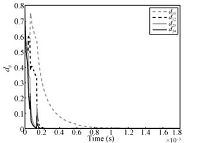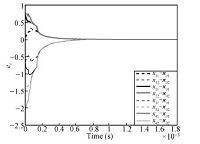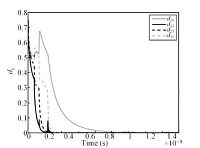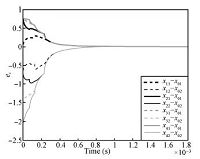Maintaining connectivity in a multi-agent system is necessary in such problems as rendezvous,flocking,swarming and so on. These problems have been studied for both single-integrator multi-agent systems[1, 2, 3, 4, 5, 6] and double-integrator multi-agent systems[2, 7, 8]. There are two types of rendezvous problems,namely leaderless rendezvous problem and leader-following rendezvous problem. While the leaderless rendezvous problem requires that the outputs of all agents asymptotically approach a same location,the leader-following rendezvous problem further requires that the outputs of all agents approach a given trajectory asymptotically. So far,the study of the problem of rendezvous with connectivity preservation is mainly focused on the leaderless case[1, 3, 4, 5, 6] with a few exceptions where the problem of leader-following rendezvous with connectivity preservation is studied[2, 7, 8]. Reference [2] studied the leader following rendezvous with connectivity preservation for both single-integrator and double-integrator systems using a discontinuous control law. Reference [8] studied the leader-following rendezvous with connectivity preservation for double-integrator systems where the leader was also a double integrator system. Reference [7] also studied the leader following rendezvous with connectivity preservation for double-integrator systems under a class of leader systems including double-integrator and harmonic systems.
In this paper,we will consider the problem of leader-following rendezvous with connectivity preservation of single-integrator multi-agent systems. In comparison with [2],we employ a continuous control law,and our control law does not need to know the upper bound of the derivative of the leader signal.
The problem formulation in this paper is,in spirit,similar to that of [7]. However,the approach of this paper is different from that of [7] in that our control law does not contain a distributed observer,and is thus much simpler than the one in [7]. We also need to establish lemma to lay the foundation of the main result of the current paper.
The rest of this paper is organized as follows. In Section II,we give a precise formulation of the problem of leader-following rendezvous with connectivity preservation for single-integrator multi-agent systems. In Section III,we present our main result. An example is presented in Section IV. Some concluding remarks are given in Section V. Finally,we note that a preliminary version of this paper appears in [9].
II. PROBLEM FORMULATION
Consider a group of single-integrator systems:
\begin{align}
\dot{x}_i =u_i,~~i=1,\cdots,N,
\end{align}
(1)
\begin{align}
\dot{x}_0=Sx_0,
\end{align}
(2)
The system composed of (1) and (2) can be viewed as a multi-agent system of $(N+1)$ agents with (2) as the leader and the $N$ subsystems of (1) as the $N$ followers. With respect to the system composed of (1) and (2),we can define a digraph(See appendix for a self-contained summary of digraph). $\bar{\mathcal {G}} (t) = (\bar{\mathcal {V}}, \bar{\mathcal E} (t))$ where $\bar{\mathcal {V}} =\{0,1,\cdots, N\}$ with $0$ associated with the leader system and $i = 1, \cdots,N$,associated with the $i$th subsystem of (1),and $\bar{\mathcal {E}}(t) \subseteq\bar{\mathcal {V}} \times \bar{\mathcal {V}}$. The set $\bar{\mathcal {V}}$ is called the node set of $\bar{\mathcal {G}} (t)$ and the set $\bar{\mathcal E} (t) $ is called the edge set of $\bar{\mathcal {G}} (t)$. We use the notation $\bar{\mathcal {N}}_i(t)$ to denote the neighbor set of node $i$ for $i = 0,1,\cdots,N$. The definition of $\bar{\mathcal {E}} (t)$ associated with the system composed of (1) and (2) is as follows.
Given any $r > 0$ and $\epsilon \in (0,r)$,for any $t \geq 0$, $\bar{\cal E}(t)=\{(i,j)\mid i,j \in \bar{\mathcal {V}}\}$ is defined such that:
1) $\bar{\cal E} (0)=\{(i,j)\mid \|x_i(0)-x_j(0)\|< (r-\epsilon)$, $i,j = 1,\cdots$,$N \}$ $\cup$ $\{(0,j)\mid \|x_0(0)-x_j(0)\|< (r-\epsilon),j = 1,\cdots,N \}$;
2) if $\|x_i(t)-x_j(t)\|\geq r$,then $(i,j)\notin \bar{\cal E} (t)$;
3) $(i,0)\notin \bar{\cal E} (t)$,for $i = 0,1,\cdots,N$;
4) for $ i = 0,1,\cdots,N$,$j = 1,\cdots,N$,if $(i,j)\notin \bar{\cal E}(t^-)$ and $\|x_i(t)-x_j(t)\|< (r-\epsilon)$,then $(i,j) \in \bar{\cal E}(t)$;
5) for $ i = 0,1,\cdots,N$,$j = 1,\cdots,N$,if $(i,j)\in \bar{\cal E}(t^-)$ and $\|x_i(t)-x_j(t)\|< r$,then $(i,j) \in \bar{\cal E}(t)$.
${\bf Remark 1.}$ The definition here is the same as that in [7]. If $\epsilon = 0$,then the above definition is similar to that given in [5]. Thus the physical interpretation of $r$ is the sensing radius of the distance sensor of each follower. The number $\epsilon$ is to introduce the effect of hysteresis. It is noted that the leader does not have a control and,therefore,there is no edge from a follower to the leader.
We will consider the following distributed state feedback control
law
\begin{align}
u_i =Sx_i+h_i(x_i-x_j,j \in \bar{{\mathcal N}}_i(t)),
~~i=1,\cdots,N,\label{glaw}
\end{align}
(3)
The control law (3) is called a distributed state feedback control law because,at any time instant $t$,the control $u_i$ can take $x_j$,$j \neq i$,for feedback control if and only if node $j$ is a neighbor of node $i$.
Define a subgraph ${\mathcal {G}}(t)=({\mathcal {V}},{\mathcal {E}} (t))$ of $\bar{\mathcal {G}}(t)$ where ${\mathcal {V}}=\{1$, $\cdots$,$N\}$,and ${\mathcal {E}}(t) \subseteq {\mathcal {V}} \times {\mathcal {V}}$ is obtained from $\bar{{\mathcal {E}}}(t)$ by removing all edges from node 0 to the nodes in ${\cal V}$. Clearly, ${\mathcal {G}}(t)$ is an undirected graph. For $i = 1,\cdots,N$, let $\mathcal {N}_i(t) = \bar{\mathcal {N}}_i(t) \cap {\mathcal {V}}$. It can be seen that for $i = 1,\cdots,N$,$\mathcal {N}_i(t)$ is the neighbor set of node $i$ with respect to ${\mathcal {G}}(t)$.
The problem of leader-following rendezvous with connectivity preservation is described as follows.
${\bf Definition 1.}$ Given the multi-agent system composed of (1) and (2),find a control law of form (3) such that for all initial conditions $x_i (0)$,$i=0,1,\cdots,N$,that make $\bar{\mathcal {G}}(0)$ connected,the closed-loop system has the following properties:
1) $\bar{\mathcal {G}}(t)$ is connected for all $t\geq 0$;
2) $\lim_{t\rightarrow \infty} (x_i-x_0)=0$,$i = 1,\cdots,N$.
${\bf Remark 2.}$ The problem of leader-following rendezvous with connectivity preservation defined here is similar to the leader-following problem of rendezvous with connectivity preservation defined for double-integrator system in [7].
III. MAIN RESULT
Like in [7$-$8],we will adopt the potential function approach to
design our control law. Thus,we will first introduce a bounded
potential function introduced in [8] as follows
\begin{align}
\psi(s)= \frac{ s^2}{r-s+\frac{r^2}{Q}},~~~ 0 \leq s \leq r,
\end{align}
(4)
\begin{align}
\psi(r)=Q > \alpha \psi (r-\epsilon) + \beta.
\end{align}
(5)
Now we are ready to propose our distributed state feedback
control law as follows:
\begin{align}
u_i= &\ S x_i- \gamma \sum_{j\in \bar{\mathcal {N}}_i(t)} \frac{\partial \psi (\|x_i-x_j\|)}{\partial x_i} =\nonumber \\
&\ S x_i -\gamma \sum_{j\in \bar{\mathcal {N}}_i(t)}
w_{ij}(t)(x_i-x_j),~~~~i=1,\cdots,N,
\end{align}
(6)
\begin{align}
w_{ij}(t)=\left\{
\begin{array}{ll}
\dfrac{2 r-\|x_i-x_j\|+\frac{2 r^2}{Q}}{(r-\|x_i-x_j\|+\frac{r^2}{Q})^2},&(j,i)\in \bar{{\mathcal {E}}}(t),\\
0,&\mbox{otherwise},\\
\end{array}
\right.
\end{align}
(7)
Let $\phi (s) = \frac{2r-s+\frac{2r^2}{Q}}{(r-s+\frac{r^2}{Q})^2}$ for $ 0 \leq s \leq r$. Then $ 0 < \frac{2r+\frac{2r^2}{Q}}{(r+\frac{r^2}{Q})^2} =$ $\phi (0)$ $\leq$ $\phi (s) \leq \phi (r)=\frac{r+\frac{2 r^2}{Q}}{(\frac{r^2}{Q})^2}$ over $s \in [0,r]$. Let $a = \frac{2r+\frac{2r^2}{Q}}{(r+\frac{r^2}{Q})^2}$ and $b = \frac{r+\frac{2 r^2}{Q}}{(\frac{r^2}{Q})^2}$. Then,for all $(j,i)\in \bar{\mathcal {E}}(t)$,$0 < a\leq w_{ij}(t)$ $\leq$ $b $.
Let $\bar{x}_i=x_i-x_0$,$i=0,1,\cdots,N$. Then,in terms of
$\bar{x}_i$,the closed-loop system is
\begin{align}
\dot{\bar{x}}_i&=S \bar{x}_i -\gamma \sum_{j\in \bar{\mathcal {N}}_i(t)}
w_{ij}(t)(\bar{x}_i-\bar{x}_j),~~~~i=1,\cdots,N.
\end{align}
(8)
Let $\bar{x}=\left[
\begin{array}{cccc}
\bar{x}_1^{\rm T} & \bar{x}_2^{\rm T} & \cdots & \bar{x}_N^{\rm T} \\
\end{array}
\right]^{\rm T}$.
Then the closed-loop system can be put in the following compact
form
\begin{align}
\dot{\bar{x}}=(I_N \otimes S-\gamma H (t) \otimes I_n)\bar{x},
\end{align}
(9)
Before presenting our main result,we will establish the following lemma.
${\bf Lemma 1.}$ Assume graph $\bar{\mathcal {G}} (t)$ is connected for all $t \geq 0$,and $\bar{\mathcal {G}} (t_1) \subset \bar{\mathcal {G}} (t_2)$ whenever $ t_2 \geq t_1 \geq 0$. Then
1) There exist constant positive definite matrices $H_1$ and $H_2$ such that $0 < H_1 \leq H (t) \leq H_2$ for all $t \geq 0$;
2) Let $\gamma_0 = \frac{\delta \lambda_M (H_2) }{\lambda^2_m (H_1)}$ where $\lambda_M (H)$ and $\lambda_m (H)$ are the largest and smallest eigenvalues of a positive definite matrix $H$ and $\delta \geq0$. Then,for all $\gamma > \gamma_0$,$\gamma \lambda^2_m (H_1) - \delta \lambda_M (H_2) > 0$ and $\gamma H^2 (t) \otimes I_n- \delta H (t) \otimes I_n \geq (\gamma \lambda^2_m (H_1) - \delta \lambda_M (H_2) )I_{Nn}$ for all $t \geq 0$.
${\bf Proof.}$ 1) Let $\bar{\mathcal {G}}_0 = (\bar{\mathcal {V}},
\bar{\mathcal {E}}_0 ) $ be any connected graph such that
$\bar{\mathcal {G}}_0 \subset \bar{\mathcal {G}} (0)$. Let
\begin{align}
H_1=\left[\begin{array}{cccc}
\delta_1 & -a_{12} & \cdots & -a_{1N} \\
-a_{12} & \delta_2 & \cdots & -a_{2N} \\
\vdots & \vdots & \ddots & \vdots \\
-a_{1N} & -a_{2N} & \cdots & \delta_N \\
\end{array}
\right],
\end{align}
(10)
\begin{align}
a_{ij}=\left\{
\begin{array}{ll}
a,&(j,i)\in \bar{{\mathcal {E}}}_0,\\
0,&\mbox{otherwise},\\
\end{array}
\right.
\end{align}
(11)
\begin{align}
H_2=\left[\begin{array}{cccc}
N b & -b & \cdots & -b \\
-b & N b & \cdots & -b \\
\vdots & \vdots & \ddots & \vdots \\
-b & -b & \cdots & N b \\
\end{array}
\right].
\end{align}
(12)
Note that $H_1 = -M_1 + \Delta_1$,where $M_1$ is a constant Metzler matrix with zero row sum whose nonzero off-diagonal entries are equal to $a$,and $\Delta_1$ is a nonnegative diagonal matrix with at least one positive diagonal entry. It can be seen that $\Gamma (M_1) = \mathcal {G}_0$,where $\mathcal {G}_0$ is the subgraph of $\bar{\mathcal {G}}_0$ obtained from $\bar{\mathcal {G}}_0$ by removing node $0$ and all edges adjacent to node $0$. By Remark A1,$H_1$ is positive definite.
Let $H-H_1=$ \begin{align*} \left[\begin{array}{cccc} \beta_1-\delta_1 & (a_{12}-w_{12}) & \cdots & (a_{1N}-w_{1N}) \\ (a_{12}-w_{12}) & \beta_2-\delta_2 & \cdots & (a_{2N}-w_{2N}) \\ \vdots & \vdots & \ddots & \vdots \\ (a_{1N}-w_{1N}) & (a_{2N}-w_{2N}) & \cdots & \beta_N-\delta_N \\ \end{array} \right]. \end{align*}
Since for $i = 1,\cdots,N$,$(\beta_i - \delta_i) = \sum_{j=0,j\neq i}^N (w_{ij}-a_{ij}) \geq \sum_{j=1,j\neq i}^N (w_{ij}-a_{ij}) \geq 0$,$H-H_1$ is positive semi-definite by Gersgorin Theorem.
Next,let $H_2-H=$ \begin{align*} \left[\begin{array}{cccc} Nb-\beta_1 & -(b-w_{12}) & \cdots & -(b-w_{1N}) \\ -(b-w_{12}) & Nb-\beta_2 & \cdots & -(b-w_{2N}) \\ \vdots & \vdots & \ddots & \vdots \\ -(b-w_{1N}) & -(b-w_{2N}) & \cdots & Nb-\beta_N \\ \end{array} \right]. \end{align*} Then,for $i = 1,\cdots,N$,$(Nb - \beta_i) = \sum_{j=0,j\neq i}^N (b-w_{ij}) \geq 0 $. Thus,$H_2-H$ is positive semi-definite by Gersgorin theorem. Thus we have $0<H_1\leq H (t) \leq H_2$ for all $t \geq 0$.
2) Let $\lambda_i (t)$ and $\alpha_i (t)$,$i = 1,\cdots,N$,be the eigenvalues and the eigenvectors of $H (t)$,respectively. Let $e_i$,$i$ $=1,\cdots,n$,be the $i$th column of $I_n$. Then it can be verified that for $i = 1,\cdots,N$,$j = 1,\cdots,n$, $(\gamma H^2 (t)\otimes I_n$ $-$ $\delta H (t) \otimes I_n) (\alpha_i \otimes e_j) = (\gamma \lambda^2_i - \delta \lambda_i)(\alpha_i \otimes e_j)$,and $(\alpha_i$ $\otimes$ $e_j)$ are linearly independent. Thus,the eigenvalues of ($\gamma H^2 (t) \otimes I_n- \delta H (t) \otimes I_n)$ belong to the set $\{ (\gamma \lambda^2_i$ $-$ $\delta \lambda_i) |i=1, \cdots,N \}$ which has a lower bound $\gamma \lambda^2_m (H_1)$ $-$ $\delta \lambda_M (H_2) $ since $H_1\leq H (t) \leq H_2$. For all $\gamma > \gamma_0$,$\gamma \lambda^2_m (H_1)$ $-$ $\delta\lambda_M (H_2) >0 $,therefore for all $\gamma > \gamma_0$,$\gamma H^2 (t)\otimes I_n$ $-$ $\delta H (t)$ $\otimes$ $I_n \geq(\gamma \lambda^2_m (H_1)-\delta \lambda_M (H_2) ) I_{Nn} $.
Now we present our main result.
${\bf Theorem 1.}$ Given any $r > 0$ and $\epsilon \in (0,r)$,the problem of leader-following rendezvous with connectivity preservation of the system composed of (1) and (2) is solvable by a control protocol of the form of (6).
${\bf Proof.}$ Given $r>0$ and $\epsilon \in (0,r)$,the control law
is determined by two design parameters $Q$ and $\gamma$. Let $\alpha
= {N(N-1)}/{2}+N$,$\beta = 0$,and
\begin{align}
Q_{\max} = \frac{\alpha
(r-\epsilon)^2}{\epsilon}.
\end{align}
(13)
To determine $\gamma$,note that there are only finitely many connected graphs with $N$ edges (an undirected edge is counted as one edge). Denote these graphs by $\bar{\mathcal {G}}_i$,$ i =$ $1,\cdots,p$,where $p$ is some positive integer. For each $\bar{\mathcal {G}}_i$,we can define a matrix,$\bar{H}_i$,in the same way as we define $H_1$ in (10). Denote the minimal eigenvalue of $\bar{H}_i$ by $\lambda_m (\bar{H}_i)$. Let $\lambda_m = \min \{\lambda_m (\bar{H}_1),\cdots,\lambda_m (\bar{H}_p)\}$. Let $\gamma_0$ $=$ ${\|S\| \lambda_M (H_2) }/{\lambda_m^2}$ where $H_2$ is the same as defined in (12). For any $t \geq 0$,if $\bar{\mathcal {G}} (t)$ is connected,there exists some $1$ $\leq$ $i\leq p$ such that $\bar{\mathcal {G}}_i \subset \bar{\mathcal {G}} (t)$. Thus,by Lemma 1,for all $\gamma$ $>$ $\gamma_0$,$\gamma \lambda_m^2 - \|S\| \lambda_M (H_2) > 0$,and for any $t \geq 0$, $\gamma H^2 (t)$ $\otimes$ $I_n- \|S\| H (t) \otimes I_n \geq (\gamma \lambda_m^2 - \|S\| \lambda_M (H_2) )I_{Nn}$ if $\bar{\mathcal {G}} (t)$ is connected. Fix this $\gamma$ and let $\lambda_\gamma = \gamma \lambda_m^2 - \|S\| \lambda_M (H_2) $ and $P (t)$ $=$ $\gamma H^2 (t) \otimes I_n- \|S\| H (t) \otimes I_n$.
Now we will first show that the above control law is such that
graph $\bar{\mathcal {G}} (t)$ is connected for all $t \geq
0$. For this purpose,let
\begin{align}
V= \frac{1}{2}\sum_{i=1}^N \sum_{j\in \mathcal {N}_i(t)} \psi
(\|\bar{x}_i-\bar{x}_j\|)+ \sum_{i=1}^N b_i(t)
\psi(\|\bar{x}_i\|),
\end{align}
(14)
We call $V$ as an energy function for (9). It can be seen that
for all initial conditions $x_i (0)$,$i=0,1,\cdots,N$,
$\bar{\mathcal {G}}(0)$ is connected,
\begin{align}
V (0) \leq Q_{\max}.
\end{align}
(15)
\begin{align}
\sum_{j\in \bar{\mathcal {N}}_i(t)} w_{ij}(t)(\bar{x}_i-\bar{x}_j)=\frac{1}{\gamma}(S \bar{x}_i-
\dot{\bar{x}}_i),~~i=1,\cdots,N.
\end{align}
(16)
Then the derivative of the energy function (14) along (9)
satisfies
\begin{align}
& \dot{V}=\frac{1}{2}\sum_{i=1}^N \sum_{j\in \mathcal {N}_i(t)}
\dot{\psi}
(\|\bar{x}_i-\bar{x}_j\|)+ \sum_{i=1}^N b_i(t) \dot{\psi}(\|\bar{x}_i\|)= \nonumber\end{align} \begin{align}
&\sum_{i=1}^N \dot{\bar{x}}_i^{\rm T} \sum_{j\in \mathcal {N}_i(t)}w_{ij}(t)(\bar{x}_i-\bar{x}_j)+
\sum_{i=1}^N \dot{\bar{x}}_i^{\rm T} w_{i0}(t)\bar{x}_i= \nonumber\\
&\sum_{i=1}^N \dot{\bar{x}}_i^{\rm T} \sum_{j\in \bar{\mathcal {N}}_i(t)} w_{ij}(t)(\bar{x}_i-\bar{x}_j)=
\sum_{i=1}^N \dot{\bar{x}}_i^{\rm T} \frac{1}{\gamma}(S \bar{x}_i- \dot{\bar{x}}_i)= \nonumber\\
&\frac{1}{\gamma} \sum_{i=1}^N \dot{\bar{x}}_i^{\rm T} S\bar{x}_i -\frac{1}{\gamma} \sum_{i=1}^N \dot{\bar{x}}_i^{\rm T} \dot{\bar{x}}_i=
\frac{1}{\gamma} \dot{\bar{x}}^{\rm T} (I_N \otimes S)\bar{x}-\frac{1}{\gamma} \dot{\bar{x}}^{\rm T} \dot{\bar{x}}= \nonumber\\
&\frac{1}{\gamma}\bar{x}^{\rm T} (I_N \otimes S-\gamma H(t)\otimes I_n)^{\rm T} (I_N\otimes S)\bar{x}- \nonumber\\
&\frac{1}{\gamma}\bar{x}^{\rm T} (I_N \otimes S-\gamma H(t)\otimes I_n)^{\rm T} (I_N \otimes S-\gamma H(t)\otimes I_n)\bar{x}= \nonumber\\
&\frac{1}{\gamma} \bar{x}^{\rm T}(I_N \otimes S^{\rm T} S-\gamma H(t)\otimes S-I_N \otimes S^{\rm T} S+\gamma H(t)\otimes S^{\rm T} + \nonumber\\
&\gamma H(t)\otimes S-\gamma^2 H(t) H(t)\otimes I_n ) \bar{x}= \nonumber\\
&-\bar{x}^{\rm T} (\gamma(H(t) H(t) \otimes I_n-H(t)\otimes S^{\rm T})\bar{x}= \nonumber\\
&-\bar{x}^{\rm T} (\gamma H(t) H(t) \otimes I_n)\bar{x}+\sum_{i=1}^N w_{i0} \bar{x}_i^{\rm T} S^{\rm T} \bar{x}_i + \nonumber\\
& \frac{1}{2} \sum_{i=1}^N \sum_{j\in \mathcal {N}_i(t)} w_{ij} (\bar{x}_i- \bar{x}_j)^{\rm T} S^{\rm T}(\bar{x}_i- \bar{x}_j)\leq \nonumber\\
&-\bar{x}^{\rm T} (\gamma H(t) H(t) \otimes I_n)\bar{x}+\sum_{i=1}^N w_{i0} \|S\| \bar{x}_i^{\rm T} \bar{x}_i + \nonumber\\
&\frac{1}{2} \sum_{i=1}^N \sum_{j\in \mathcal {N}_i(t)} w_{ij}\|S\| (\bar{x}_i- \bar{x}_j)^{\rm T} (\bar{x}_i- \bar{x}_j)= \nonumber\\
&-\bar{x}^{\rm T}((\gamma H(t) H(t)-\|S\| H(t) )\otimes I_n) \bar{x}= -\bar{x}^{\rm T} P (t) \bar{x}.
\end{align}
(17)
By the continuity of the solution of (9),there exists $0 < t_1$
$\leq$ $\infty$ such that
$\bar{\mathcal {G}}(t) = \bar{\mathcal {G}}(0)$ for all $t \in [0,t_1)$.
If $t_1 = \infty$,then the graph is connected for all $t \geq 0$.
Thus,$P (t) \geq \lambda_\gamma I_{Nn}$ for all $t \geq 0$.
Therefore,for all $t \geq 0$,
\begin{align}
\dot{V}(t) \leq - \lambda_\gamma \|\bar{x}\|^2.
\end{align}
(18)
\begin{align}
V(t) \leq V(0) \leq Q_{\max} < Q = \psi(r),~~~\forall t \geq 0.
\end{align}
(19)
\begin{align}
&\bar{\mathcal {G}}(t)=\bar{\mathcal {G}}(0),~~~t\in [0,t_1),\nonumber \\
&\bar{\mathcal {G}}(t_1)\neq \bar{\mathcal {G}}(0).
\end{align}
(20)
\begin{align}
V(t) \leq V(0) \leq Q_{\max} < Q = \psi(r),~~~\forall t \in [0,
t_1).
\end{align}
(21)
Assume,for some $(i,j)\in\bar{\mathcal {E}}(0)$,$(i,j)\notin \bar{\mathcal {E}}(t_1)$. Then $\lim_{t \rightarrow t^{-}_1 } \|x_i-x_j\| =r$,which implies $V (t_1) \geq Q$ thus contradicting (21). Thus,the graph will not lost edges at time $t_1$. Therefore, $\bar{\mathcal {G}}(t_1)\supset \bar{\mathcal {G}}(0)$.
Since $\bar{\mathcal {G}}(t)$ can only have finitely many edges, there exists a finite integer $k > 0$ such that \begin{align*} &\bar{\mathcal {G}}(t) =\bar{\mathcal {G}}(0),\qquad\qquad\quad~~~ ~ t\in [0,t_{1}),\\ &\bar{\mathcal {G}}(t) =\bar{\mathcal {G}}(t_i) \supset \bar{\mathcal {G}}(t_{i-1}),~~~~~t\in [t_{i},t_{i+1}),~ i =1,\cdots,k-1 ,\\ &\bar{\mathcal {G}}(t) =\bar{\mathcal {G}}(t_{k}) \supset \bar{\mathcal {G}}(t_{k-1}),~~~~t\in [t_{k},\infty). \end{align*}
Thus,along any trajectory of the closed-loop system,we have
\begin{align}
\dot{V}(t) \leq -\lambda_\gamma \|\bar{x}\|^2,~~~ t \geq t_k.
\end{align}
(22)
\begin{align}
V(t) \leq V(0)\leq Q_{\max} < Q=\psi(r),~~~\forall t \geq 0.
\end{align}
(23)
Next,we will show $\lim_{t \rightarrow \infty} \bar{x} (t) =0$. Since graph $\bar{\mathcal {G}}(t)$ is connected for all $t\geq t_k$,and $H(t)$ is continuous and bounded for all $t\geq t_k$,by (14) and (22),$\bar{x}_i-\bar{x}_j$ with $j$ $\in$ $\bar{\mathcal {N}}_i(t_k)$ is bounded for all $t\geq t_k$,and $\lim_{t\rightarrow \infty}V(t)$ exists. From (9),$\dot{\bar{x}}$ is bounded over $t\geq t_k$. Thus $\dot{V}(t)$ is uniformly continuous for all $t\geq t_k$. Thus by Barbalat$'$s Lemma[10], $\lim_{t\rightarrow \infty}\dot{V}(t)=0$. Thus,(22) implies $\lim_{t\rightarrow \infty} \lambda_\gamma \|\bar{x}\|^2 = 0$. Therefore, $\lim_{t \rightarrow \infty} \bar{x} (t) =0$,i.e.,$\lim_{t \rightarrow \infty} (x_i - x_0)=0$,$i=$ $1$,$\cdots$,$N$. \hfill$\square$
${\bf Remark 3.}$ Since we allow our leader system to be a class of autonomous linear systems of form (2),our control law relies on matrix $S$ defining the leader system. This feature is a reminiscence of the classical internal model design method which can be found in [11, 12]. It is this feature that enables a control law to track,instead of a single trajectory,but a class of trajectories. It is noted that knowing the information of the matrix $S$ is less demanding than knowing the trajectory of the leader. For example,a sinusoidal signal $A \sin (\omega t + \phi)$ is defined by three parameters $A$,$\omega$,and $\phi$. The matrix $S$ is solely defined by $\omega$. By using $S$ in the control law,we can handle a sinusoidal signal with frequency $\omega$,arbitrary amplitude $A$,and arbitrary initial phase $\phi$. In the special case where the leader signal is step function or ramp function,we simply take $S=0$,or $S$ $=$ $\left [ \begin{array}{cc} 0 & 1 \\ 0 & 0 \end{array} \right]$. Therefore,in these two special cases,the control law does not really depend on any parameter of the leader signal.
IV. AN EXAMPLE
Consider the multi-agent system composed of (1) and (2) with $n = 2$
and $N =4$. Assume the sensing range is $r=1$ and $\epsilon=0.1$. To
obtain the design parameter $Q$ in the potential function,using (5)
with $\alpha={N(N-1)}/{2}+N=10$ gives ${\alpha
(r-\epsilon)^2}/{\epsilon}=81$. Then taking $Q=82$ makes (5)
satisfied. Thus the potential function is
\begin{align}
\psi(s)= \dfrac{ s^2}{1-s+\dfrac{1}{82}},~~~0 \leq s \leq r.
\end{align}
(24)
With these parameters,we have evaluated the performance of the control law (6) for two different leader systems.
${\bf Case 1.}$ The leader system generates a ramp signal
In this case, $$S=\left[ \begin{array}{cc} 0 & 1 \\ 0 & 0 \\ \end{array} \right].$$ Some of the simulation results are shown in Fig. 1 and Fig. 2. Fig. 1 shows the distances of the edges $\{(0,1)$,$(1,2)$, $(2,3)$,$(3,4) \}$,which constitute the initial edge set. It can be seen that the network is connected. Fig. 2 further shows the time response of the state of all the followers. It can be seen that all the followers asymptotically approach the leader.

|
Download:
|
| Fig. 1.Distances among agents. | |

|
Download:
|
| Fig. 2.Position difference between follower and leader. | |
${\bf Case 2.}$ The leader system generates a sinusoidal signal
In this case,$$S=\left[ \begin{array}{cc} 0 & 1 \\ -1 & 0 \\ \end{array} \right]$$ Fig. 3 shows the distances of the edges $\{(0,1)$,$(1,2)$, $(2,3)$,$(3,4) \}$,which constitute the initial edge set. Fig. 4 further shows the time response of the state of all the followers. Satisfactory performance is observed.

|
Download:
|
| Fig. 3.Distances among agents. | |

|
Download:
|
| Fig. 4.Position difference between follower and leader. | |
In this paper,we have considered the problem of leader-following rendezvous with connectivity preservation for a multiple single-integrator system,where the leader system can be any linear autonomous system. We have proposed a distributed state feedback control protocol that is able to maintain the connectivity of the system,and,at the same time,achieve asymptotic tracking of all followers to the output of the leader system.
AppendixWe first introduce some graph notation,which can be found in [13]. A digraph $\mathcal {G}=(\mathcal {V},\mathcal {E})$ consists of a finite set of nodes $\mathcal {V}$ $=$ $\{1,\cdots,N\}$ and of an edge set $\mathcal {E} = \{(i,j)$,$i,j \in \mathcal {V}$,$i \neq j \}$. Node $i$ is called a neighbor of node $j$ if the edge $(i,j)$ $\in$ $\mathcal {E}$. $\mathcal {N}_i$ denotes the subset of $\mathcal {V}$ that consists of all the neighbors of node $i$. If graph $\mathcal{G}$ contains a sequence of edges of the form $({i_1},{i_2})$,$({i_2},{i_3}),\cdots,({i_{k}}, {i_{k+1}})$,then the set of $\{({i_1},{i_2}),({i_2},{i_3}), \cdots,({i_{k}}$,${i_{k+1}}) \}$ is called a path of $\mathcal{G}$ from ${i_1}$ to ${i_{k+1}}$,and node ${i_{k+1}}$ is said to be reachable from node ${i_{1}}$. Edge $(i,j)$ is called undirected if $(i,j)$ $\in$ $\mathcal {E}$ implies $(j,i)\in \mathcal {E}$. The graph is called undirected if every edge in $\mathcal {E}$ is undirected. A graph is called connected if there exists a node $i$ such that any other nodes are reachable from node $i$. Node $i$ is called a root of the graph. Digraph $\mathcal{G}_s = (\mathcal {V}_s,\mathcal {E}_s)$ is a subgraph of $\mathcal{G} = (\mathcal {V},\mathcal {E})$ if $\mathcal {V}_s\subseteq\mathcal {V}$ and $\mathcal {E}_s$ $\subseteq$ $\mathcal {E}$ $\cap$ $(\mathcal {V}_s$ $\times$ $\mathcal {V}_s)$.
A matrix $\mathcal {L}=[l_{ij}]\in \textbf{R}^{N\times N}$ with zero row sum is said to be a Laplacian matrix of graph $\mathcal{G}$ if, for $i,j = 1,\cdots,N,i \neq j$,$l_{ij}<0$ iff $\Leftrightarrow$ $(j,i)\in \mathcal {E}$,and $l_{ij} = l_{ji}$ if $(j,i)$ is a undirected edge of $\mathcal {E}$. Clearly, $\mathcal{L}{1}_N=0$.
Given any matrix $M=[m_{ij}]\in \textbf{R}^{N\times N},$ one can define a graph denoted by $\Gamma (M) = ({\mathcal {V}},{\mathcal {E}})$ where ${\mathcal {V}}=\{1,\cdots,N\}$,and and $\mathcal {E} = \{(i,j)|m_{ji} \neq 0,i\neq j,i,j=1,\cdots,N \}$. Clearly,if $\mathcal {L}$ is any Laplacian matrix of graph $\mathcal {G}$,then $\Gamma (\mathcal {L}) = \mathcal {G}$. A matrix of $M$ $=$ $[m_{ij}]_{N\times N}$ with nonnegative off-diagonal elements and zero row sums is called Metzler matrix. If $L$ is the Laplacian of some graph $G$,then $-L$ is a Metzler matrix.
${\bf Remark A1.}$ It is shown in [14] that a Metzler matrix has at least one zero eigenvalue and all the nonzero eigenvalues have negative real parts. Furthermore,a Metzler matrix has exactly one zero eigenvalue and its null space is span$\{\textbf{1}\}$ if and only if the associated graph is connected. A symmetric Metzler matrix is negative semi-definite. Let $M$ be a symmetric Metzler matrix whose graph is connected. Let $\Delta ={\rm diag}\{a_{10},\cdots,a_{N0}\}$,where $a_{i0}$ $\geq$ $0$ for $i = 1,\cdots,N$. Then for any nonzero,nonnegative diagonal matrix $\Delta$,$-M + \Delta$ is positive definite.
| [1] | Ajorlou A, Momeni A, Aghdam A. A class of bounded distributed control strategies for connectivity preservation in multi-agent systems. IEEE Transactions on Automatic Control, 2010, 55(12):2828-2833 |
| [2] | Cao Y C, Ren W. Distributed coordinated tracking with reduced interaction via a variable structure approach. IEEE Transactions on Automatic Control, 2012, 57(1):33-48 |
| [3] | Dimarogonas D V, Johansson K H. Bounded control of network connectivity in multi-agent systems. IET Control Theory and Applications, 2010, 4(8):1330-1338 |
| [4] | Ji M, Egerstedt M. Connectedness preserving distributed coordination control over dynamic graphs. In:Proceedings of the 2005 American Control Conference. Portland, OR, USA:IEEE, 2005. 93-98 |
| [5] | Ji M, Egerstedt M. Distributed coordination control of multiagent systems while preserving connectedness. IEEE Transactions on Robotics, 2007, 23(4):693-703 |
| [6] | Zavlanos M M, Pappas G J. Potential fields for maintaining connectivity of mobile networks. IEEE Transactions on Robotics, 2007, 23(4):812-816 |
| [7] | Dong Y, Huang J. A leader-following rendezvous problem of double integrator multi-agent systems. Automatica, 2013, 49(5):1386-1391 |
| [8] | Su H S, Wang X F, Chen G R. Rendezvous of multiple mobile agents with preserved network connectivity. Systems and Control Letters, 2010, 59(5):313-322 |
| [9] | Dong Y, Huang J. Leader-following rendezvous with connectivity preservation of single-integrator multi-agent systems. In:Proceedings of the 12th International Conference on Control, Automation, Robotics and Vision. Guangzhou, China:IEEE, 2012. 1686-1690 |
| [10] | Slotine J J, Li W P. Applied Nonlinear Control. New Jersey:Prentice Hall, 1991 |
| [11] | Francis B A. The linear multivariable regulator problem. SIAM Journal on Control and Optimization, 1977, 15(3):486-505 |
| [12] | Huang J. Nonlinear Output Regulation:Theory and Applications. Phildelphia:SIAM, 2004 |
| [13] | Godsil C, Royle G. Algebraic Graph Theory. New York:Springer-Verlag, 2001 |
| [14] | Lin Z. Coupled Dynamic Systems:from Structure towards Stability and Stabilizability[Ph. D. dissertation], University of Toronto, Canada, 2005 |
 2014, Vol.1
2014, Vol.1 


